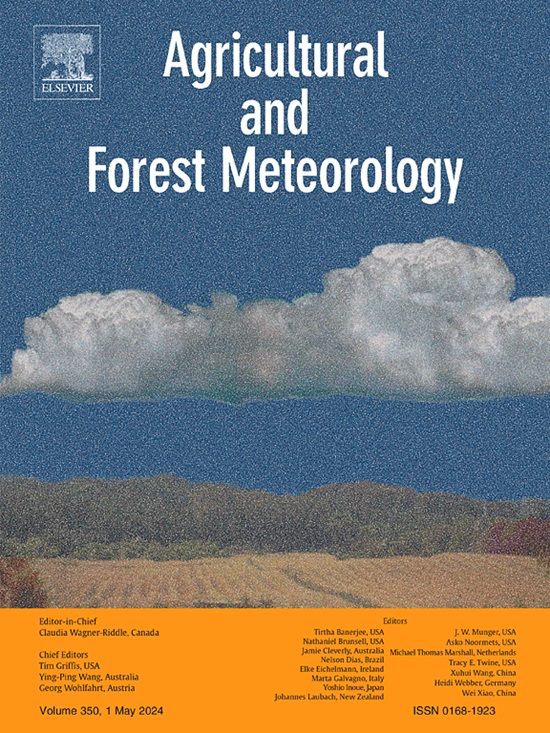Light grazing tends to enhance ecosystem carbon sequestration and resource use efficiency in a meadow steppe of northern China
IF 5.7
1区 农林科学
Q1 AGRONOMY
引用次数: 0
Abstract
Grassland ecosystems are particularly sensitive to human disturbances due to their relatively simple structure and limited resource availability. However, the responses of ecosystem carbon and water exchanges to grazing, the dominant human activity in grasslands, remain insufficiently understood. During growing seasons in 2023 and 2024, a grazing gradient experiment was conducted in a meadow steppe of northern China, incorporating four intensity levels: no grazing (CK), light grazing (LG), moderate grazing (MG), and heavy grazing (HG). Using the static chamber method, we assessed ecosystem carbon fluxes (GPP: gross primary production; ER: ecosystem respiration; NEE: net ecosystem CO2 exchange; Rh: soil heterotrophic respiration), water exchanges (ET: evapotranspiration; EP: soil evaporation), and resource use efficiencies (CUE: carbon use efficiency; WUE: water use efficiency). Results indicated that light grazing significantly enhanced NEE, CUE, and WUE compared to other treatments. In contrast, increasing grazing intensity markedly reduced carbon and water fluxes in MG and HG plots. Under grazing stress, aboveground biomass (AGB) was the primary determinant of GPP and ET changes, while ER was mainly influenced by soil microclimate and nutrients. GPP emerged as the key driver of NEE, CUE, and WUE variations. These findings highlight the contrasting roles of biotic and abiotic factors in regulating ecosystem functions and provide comprehensive evidence that light grazing could benefit carbon sequestration and resource use efficiency in the meadow steppe. Our study can offer practical and theoretical support for determining appropriate grazing intensity and promoting the sustainable management of grasslands in northern China.
中国北方草甸草原轻放牧有利于提高生态系统固碳和资源利用效率
草地生态系统结构相对简单,可利用资源有限,对人为干扰尤为敏感。然而,生态系统碳和水交换对放牧的响应(放牧是草原上主要的人类活动)仍然不够了解。在2023年和2024年的生长季,在中国北方某草甸草原进行了放牧梯度试验,将放牧强度分为不放牧(CK)、轻度放牧(LG)、中度放牧(MG)和重度放牧(HG) 4个等级。采用静态室法对生态系统碳通量(GPP:初级生产总量;ER:生态系统呼吸;NEE:净生态系统二氧化碳交换;Rh:土壤异养呼吸),水分交换(ET:蒸散发;EP:土壤蒸发)和资源利用效率(CUE:碳利用效率;WUE:水利用效率)。结果表明,与其他处理相比,轻放牧显著提高了NEE、CUE和WUE。相反,增加放牧强度显著降低了MG和HG样地的碳通量和水通量。放牧胁迫下,地上生物量(AGB)是GPP和ET变化的主要决定因素,而ER主要受土壤小气候和养分的影响。GPP是NEE、CUE和WUE变化的关键驱动因素。这些发现突出了生物因子和非生物因子在调节生态系统功能中的不同作用,为轻放牧有利于草甸草原的碳固存和资源利用效率提供了综合证据。研究结果可为确定适宜的放牧强度,促进中国北方草原的可持续管理提供理论和实践支持。
本文章由计算机程序翻译,如有差异,请以英文原文为准。
求助全文
约1分钟内获得全文
求助全文
来源期刊
CiteScore
10.30
自引率
9.70%
发文量
415
审稿时长
69 days
期刊介绍:
Agricultural and Forest Meteorology is an international journal for the publication of original articles and reviews on the inter-relationship between meteorology, agriculture, forestry, and natural ecosystems. Emphasis is on basic and applied scientific research relevant to practical problems in the field of plant and soil sciences, ecology and biogeochemistry as affected by weather as well as climate variability and change. Theoretical models should be tested against experimental data. Articles must appeal to an international audience. Special issues devoted to single topics are also published.
Typical topics include canopy micrometeorology (e.g. canopy radiation transfer, turbulence near the ground, evapotranspiration, energy balance, fluxes of trace gases), micrometeorological instrumentation (e.g., sensors for trace gases, flux measurement instruments, radiation measurement techniques), aerobiology (e.g. the dispersion of pollen, spores, insects and pesticides), biometeorology (e.g. the effect of weather and climate on plant distribution, crop yield, water-use efficiency, and plant phenology), forest-fire/weather interactions, and feedbacks from vegetation to weather and the climate system.

 求助内容:
求助内容: 应助结果提醒方式:
应助结果提醒方式:


